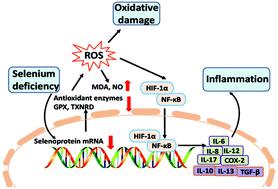当前位置:
X-MOL 学术
›
Metallomics
›
论文详情
Our official English website, www.x-mol.net, welcomes your feedback! (Note: you will need to create a separate account there.)
Se deficiency induces renal pathological changes by regulating selenoprotein expression, disrupting redox balance, and activating inflammation.
Metallomics ( IF 3.4 ) Pub Date : 2020-09-01 , DOI: 10.1039/d0mt00165a Shuang Li 1 , Qingyu Zhao 2 , Kai Zhang 2 , Wenjuan Sun 2 , Xueting Jia 2 , Yuanyuan Yang 2 , Jingdong Yin 3 , Chaohua Tang 2 , Junmin Zhang 2
Metallomics ( IF 3.4 ) Pub Date : 2020-09-01 , DOI: 10.1039/d0mt00165a Shuang Li 1 , Qingyu Zhao 2 , Kai Zhang 2 , Wenjuan Sun 2 , Xueting Jia 2 , Yuanyuan Yang 2 , Jingdong Yin 3 , Chaohua Tang 2 , Junmin Zhang 2
Affiliation

|
Selenium (Se) is closely associated with kidney disease, and renal injury often occurs together with hyposelenemia. This study was designed to reveal the mechanism underlying renal injury induced by Se deficiency in pigs. Twenty-four castrated male Yorkshire pigs were divided into two groups fed either a Se-deficient diet (0.007 mg Se per kg) or a Se-adequate diet (0.3 mg Se per kg). Serum and kidney samples were collected at the 16th week of the trial, processed, and analyzed for serum biochemistry, Se concentration, kidney index markers, histology, selenoprotein mRNA expression, redox status, and inflammatory cytokines. Dietary Se deficiency induced kidney injury, decreased (P < 0.05) Se concentrations, and increased (P < 0.05) kidney index and serum blood urea nitrogen, creatinine, and carbon dioxide values. Histological analysis indicated that Se deficiency induced inflammatory lesions and renal tubular atrophy in the renal medulla. Se deficiency downregulated (P < 0.05) nine selenoprotein genes (GPX1, SELENOW, SELENOH, SELENOP, GPX3, TXNRD2, SELENOI, SELENON, and SELENOM) and upregulated (P < 0.05) SEPHS2 in the kidneys. Se deficiency decreased (P < 0.05) the activity of glutathione peroxidase, thioredoxin reductase, and catalase, as well as the hydroxyl radical inhibition capacity, and increased (P < 0.05) the content of malondialdehyde and nitric oxide. Se deficiency increased (P < 0.05) the expression of the transcription factors NF-κB and HIF-1α, and regulated inflammatory cytokines. Se deficiency increased (P < 0.05) the expression of IL-6, IL-8, IL-12, IL-17, and cyclooxygenase-2, and decreased (P < 0.05) the expression of IL-10, IL-13, and TGF-β. These results indicated that Se deficiency induces kidney injury through the regulation of selenoproteins, oxidative stress, and inflammation.
中文翻译:

硒缺乏通过调节硒蛋白表达、破坏氧化还原平衡和激活炎症来诱导肾脏病理变化。
硒(Se)与肾脏疾病密切相关,肾损伤常与低硒血症同时发生。本研究旨在揭示猪缺硒引起肾损伤的潜在机制。将 24 头阉割的约克夏雄性猪分成两组,饲喂缺硒饮食(每公斤 0.007 毫克硒)或充足硒饮食(每公斤 0.3 毫克硒)。在试验的第 16 周收集血清和肾脏样本,处理并分析血清生化、硒浓度、肾脏指标标志物、组织学、硒蛋白 mRNA 表达、氧化还原状态和炎性细胞因子。膳食硒缺乏导致肾损伤,硒浓度降低(P < 0.05),硒浓度升高(P< 0.05) 肾脏指数和血清尿素氮、肌酐和二氧化碳值。组织学分析表明,硒缺乏会导致肾髓质炎性病变和肾小管萎缩。硒缺乏下调(P <0.05)9硒蛋白基因(GPX1,SELENOW,SELENOH,SELENOP,GPX3,TXNRD2,SELENOI,SELENON,和SELENOM)和上调(P <0.05)SEPHS2在肾脏。硒缺乏减少(P< 0.05) 谷胱甘肽过氧化物酶、硫氧还蛋白还原酶和过氧化氢酶的活性,以及羟基自由基抑制能力,并增加( P < 0.05) 丙二醛和一氧化氮的含量。Se缺乏增加(P < 0.05)转录因子NF-κB和HIF-1α的表达,并调节炎症细胞因子。硒缺乏增加(P < 0.05)IL-6、IL-8、IL-12、IL-17和环氧合酶-2的表达,降低(P < 0.05)IL-10、IL-13、和 TGF-β。这些结果表明,硒缺乏通过调节硒蛋白、氧化应激和炎症来诱导肾损伤。
更新日期:2020-09-01
中文翻译:

硒缺乏通过调节硒蛋白表达、破坏氧化还原平衡和激活炎症来诱导肾脏病理变化。
硒(Se)与肾脏疾病密切相关,肾损伤常与低硒血症同时发生。本研究旨在揭示猪缺硒引起肾损伤的潜在机制。将 24 头阉割的约克夏雄性猪分成两组,饲喂缺硒饮食(每公斤 0.007 毫克硒)或充足硒饮食(每公斤 0.3 毫克硒)。在试验的第 16 周收集血清和肾脏样本,处理并分析血清生化、硒浓度、肾脏指标标志物、组织学、硒蛋白 mRNA 表达、氧化还原状态和炎性细胞因子。膳食硒缺乏导致肾损伤,硒浓度降低(P < 0.05),硒浓度升高(P< 0.05) 肾脏指数和血清尿素氮、肌酐和二氧化碳值。组织学分析表明,硒缺乏会导致肾髓质炎性病变和肾小管萎缩。硒缺乏下调(P <0.05)9硒蛋白基因(GPX1,SELENOW,SELENOH,SELENOP,GPX3,TXNRD2,SELENOI,SELENON,和SELENOM)和上调(P <0.05)SEPHS2在肾脏。硒缺乏减少(P< 0.05) 谷胱甘肽过氧化物酶、硫氧还蛋白还原酶和过氧化氢酶的活性,以及羟基自由基抑制能力,并增加( P < 0.05) 丙二醛和一氧化氮的含量。Se缺乏增加(P < 0.05)转录因子NF-κB和HIF-1α的表达,并调节炎症细胞因子。硒缺乏增加(P < 0.05)IL-6、IL-8、IL-12、IL-17和环氧合酶-2的表达,降低(P < 0.05)IL-10、IL-13、和 TGF-β。这些结果表明,硒缺乏通过调节硒蛋白、氧化应激和炎症来诱导肾损伤。



























 京公网安备 11010802027423号
京公网安备 11010802027423号